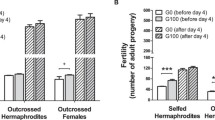Abstract.
We formulate two single-locus Mendelian models, one for androdioecy and the other one for gynodioecy, each with 3 parameters: t the male (female) fertility rate of males (females) to hermaphrodites, s the fraction of the progeny derived from selfing; and g the fitness of inbreeders. Each model is expressed as a transformation of a 3 dimensional zygotic algebra, which we interpret as a rational map of the projective plane. We then study the dynamics for the evolution of each reproductive system; and compare our results with similar published models. In this process, we introduce a general concept of fitness and list some of its properties, obtaining a relative measure of population growth, computable as an eigenvalue of a mixed mating transformation for a population in equilibrium. Our results concur with previous models of the evolution of androdioecy and gynodioecy regarding the threshold values above which the sexual polymophism is stable, although the previous models assume constant the fraction of ovules from hermaphrodites that are self pollinated, while we assume constant the fraction of the progeny derived from selfing. A stable androdioecy requires more stringent conditions than a stable gynodioecy if the amount of pollen used for selfing is negligible in comparison with the total amount of pollen produced by hermaphrodites. Otherwise, both models are identical. We show explicitly that the genotype fitnesses depend linearly on their frequencies. Simulations show that any population not at equilibrium always converges to the equilibrium point of higher fitness. However, at intermediate steps, the fitness function occasionally decreases.
Similar content being viewed by others
References
Byers, D.L., Waller, D.M.: Do plant populations purge their genetic load? effects of population size and mating history on inbreeding depression. Ann. Rev. of Ecology and Systematics 30, 479–513 (1999)
Caswell, H.: Life cycle models for plants, Lectures on Mathematics in the Life Sciences 18, Edited by L.G. Gross, R.M. Miura, Amer. Math. Soc. 1986
Charlesworth, B., Charlesworth, D.: A model for the evolution of dioecy and gynodioecy. Amer. Natur. 112, 975–997 (1978)
Charlesworth, D., Charlesworth, B.: Population genetics of partial male-sterility and the evolution of monoeocy and dioecy. Heredity (2) 41, 137–153 (1978)
Charlesworth, D.: Theories of the evolutoion of dioecy. In: M.A. Geber, T.E. Dawson, L.F. Delph, Eds. Gender and sexual dimorphism in flowering plants. Springer-Verlag, Berlin-Heidelberg, 1999, pp. 33–60
Cruden, R.W.: Pollen-ovule ratios: a conservative indicator of breeding systems in flowering plants. Evolution 31, 32–46 (1977)
Damgaard, C., Abbott, R.J.: Positive correlations between selfing rate and pollen-ovule ratio within plant populations. Evolution 49, 214–217 (1995)
Etherington, I.M.H.: Genetic algebras. Proc. Roy. Soc. Edinburgh 59, 242–258 (1939)
Galán, F.: Teorí a genética del sexo zigótico en el caso de Ecbalium elaterium. Revista de Biologí a 4, 187–220 (1964)
Grant, V.: Genetics of Flowering Plants. Columbia University, New York, 1975
Hartshorne, R.: Algebraic Geometry. Graduate Texts in Mathematics 52, Springer-Verlag, New York, 1977
Hirsch, M., Smale, S.: Differential Equations, Dynamical Systems and Linear Algebra. Academic Press, New York, San Francisco, London, 1974
Holgate, P.: Selfing in genetic algebras. J. Math. Biol. 6, 197–206 (1978)
Holsinger, K.E., Feldman, M.W., Christiansen, F.B.: The evolution of self-fertilization in plants. Amer. Natur. 124, 446–453 (1984)
Lande, R.: A quantitative genetic theory of life history evolution. Ecology 63, 607–615 (1982)
Lewis, D.: Male sterility in natural populations of hermaphrodite plants. New Phytol. 40, 56–63 (1941)
Lloyd, D.G.: Theoretical sex ratios of dioecious and gynodioecious angiosperms. Heredity 32, 11–34 (1974)
Lloyd, D.G.: The genetic contribution of individual males and females in dioecious and gynodioecious angiosperms. Heredity 32, 45–51 (1974)
Lloyd, D.G.: The maintenance of gynodioecy and androdioecy in angiosperms. Genetica 45, 325–329 (1975)
Macaulay 2 is a software system for research in algebraic geometry by Daniel R. Grayson and Michael E. Stillman, available at www.math.uiuc.edu/Macaulay2.
Pannell, J.: The maintenance of gynodioecy and androdioecy in a metapopulation. Evolution 51, 10–20 (1997)
Reed, M.L.: Algebraic structure of genetic inheritance. Bull. Amer. Math. Soc. 34, 107–130 (1997)
Richards, A.J.: Plant Breeding Systems. George Allen & Unwin, London, 1986
Ross, M.D., Weir, B.S.: Maintenance of male sterility in plant populations III. Mixed selfing and random mating. Heredity 35, 21–29 (1975)
Ross, M.D., Weir, B.S.: Maintenance of males and females in hermaphrodite populations and the evolution of dioecy. Evolution 30, 425–441 (1976)
Sassaman, C., Weeks, S.C.: The genetics of sex determination in the conchostracan shrimp Eulimnadia texana. Amer. Natur. 141, 314–328 (1993)
Schemske, D.W., Lande, R.: The evolution of self-fertilization and inbreeding depression in plants II. Empirical observations. Evolution 39, 41–52 (1985)
Sun, M., Ganders, F.R.: Mixed Mating Systems in Hawaiian Bidens (Asteraceæ). Evolution 42, 516–527 (1988)
Takebayashi, N., Delph, L.F.: An association between a trait and inbreeding depression. Evolution 54, 840–846 (2000)
Vogler, D.W., Kalisz, S.: Sex among the flowers: The distribution of plant mating systems. Evolution 55, 202–204 (2001)
Weeks, S.C., Crosser, B.R., Bennett, R., Gray, M., Zucker, N.: Maintenance of androdioecy in the freshwater shrimp Eulimnadia texana: estimates of inbreeding depression in two populations. Evolution 54, 878–887 (2000)
Wörz-Busekros, A.: Algebras in Genetics, Lecture Notes in Biomathematics 36, Springer-Verlag, New York, 1980
Author information
Authors and Affiliations
Corresponding author
Rights and permissions
About this article
Cite this article
Vargas, J., del Castillo, R. Nuclear androdioecy and gynodioecy. J. Math. Biol. 47, 199–221 (2003). https://doi.org/10.1007/s00285-003-0200-3
Received:
Revised:
Published:
Issue Date:
DOI: https://doi.org/10.1007/s00285-003-0200-3




